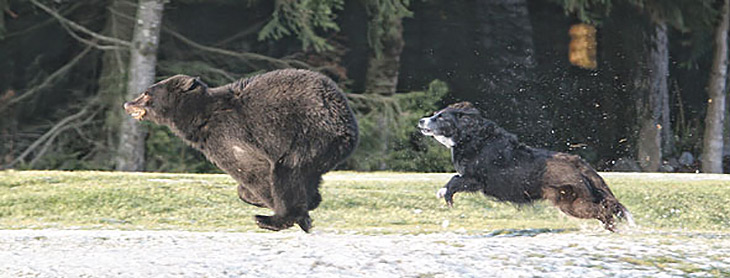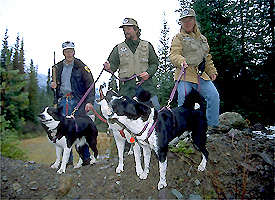
Dogs have been used by humans throughout history for hunting or to protect people and livestock from various species of carnivores. A number of canine species have been recognized for their potential to assist in bear aversion. In Arctic Canada, the Inuit have used the Canadian Eskimo Dog for centuries to attack and hold polar bears at bay (Carpenter 1989). In Louisiana, the Blackmouth cur has been used to teach persistent conflict bears to avoid certain areas (Davidson et al. 2003). The Great Pyrenees of France and Spain, the Akbash of Turkey, and the Konmondor of Spain have been used to reduce bear depredations on livestock and apiaries (Green and Woodruff 1989).
 Currently, the most active work being done using dogs to deter bears is by Carrie Hunt with Karelian Bear Dogs (KBD). KBD’s have been used for decades to track and bay game species, particularly grizzlies (the dogs were originally bred in Finland to hunt brown bears).
Currently, the most active work being done using dogs to deter bears is by Carrie Hunt with Karelian Bear Dogs (KBD). KBD’s have been used for decades to track and bay game species, particularly grizzlies (the dogs were originally bred in Finland to hunt brown bears).
The KBD’s shepherd bears by barking and chasing them from areas where they would come into conflict with people. The shepherding is combined with other aversive conditioning tools such as yelling, throwing stones, bear spray, and rubber bullets.
While much of the research has focused on finding the right breed of bear dog, it may be that the individual personality of the dog is more important than its breed. Many people who work around bears have used their own dogs as a deterrent. The dog needs to be comfortable around bears showing no fear, trained to respond to voice control so that the handler remains in charge, and exceptionally trustworthy when interacting with the public (Hunt 2003).
The advantage of using bear dogs is that they provide an added “partner” and a “safety net” while conducting conditioning on bears. They are also an excellent ambassador for public education (Hunt 2003). Although conditioning can be done without bear dogs, the use of dogs as a tool increases the options available for training a bear. For example, dogs can find and work with uncollared animals; this is particularly useful for roadside bears and in finding bears in communities or campgrounds. They can also aid in pushing bears out of large open meadows or dense wooded areas that are beyond the range of non-lethal projectiles (Hunt 2003).
The disadvantages of using bear dogs include the time and cost of either training a dog or contracting one or more over an entire field season or several years. Dogs are also a higher maintenance tool: they can not be put back in the toolbox at the end of the day, but rather, require daily care.
Visit Carrie Hunt’s website at Wind River Bear Institute for more information on using dogs to deter bears.
